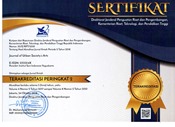The Construction of Masculinity Myths in the Namin Group's Bajidoran Arena as a Specific Gender Order"
Abstract
The Sundanese people have long recognized bajidoran as an entertainment art form that presents the aesthetics of dance and traditional Sundanese music (karawitan). However, beneath this surface lies the complexity of power struggles and masculine domination among individuals involved in the Bajidoran Enthusiast Community (Komunitas Pecinta Bajidoran or KPB). Interestingly, the power struggles are not limited to men but also involve women. This phenomenon prompts an inquiry into why bajidoran is heavily associated with practices of masculinity. This study aims to address the following questions: why is bajidoran associated with practices of masculinity, how is this construction process carried out, what are the contributing factors, and what are the implications for the KPB? This research employs a qualitative method with an ethnographic approach, wherein the researcher values the experiences and realities of the subjects under study, even if they differ radically from their own. The researcher applies three characteristics of this new ethnography: honesty, towards other facts, self-reflection, and polyvocality. Data collection involves literature review, observation, interviews, and documentation. The findings of the research explain that: 1) masculinity is strongly embedded in bajidoran due to: firstly, cultural, daily practices, and historical contexts that construct masculinity, which are dialectically intertwined with the experiences of the KPB, both present and past. Secondly, the situational and practical conditions within the bajidoran arena (social relations and interactions) have great potential to generate masculinity. 2) The process of constructing masculinity involves seven stages: production, socialization, appreciation, internalization and externalization, relationships and interactions, staging, and formation. Eight factors contribute to the construction of masculinity: patterns/sequences, the role of the mc and pesinden (vocalists), pencug ibing (leader), kendang (drum), selendang (scarf), economic capital, alcoholic beverages, and musical elements. The results of this research provide insights for the Bajidoran Enthusiast Community and relevant institutions to reconstruct the staging of masculinity in a way that accommodates gender equality.
Keywords
References
Abdulah, T. (2008). Aksi Parson Dalam Bajidoran: Sistem Mata Pencaharian Komunitas Seni Tradisional Jawa Barat. Panggung, 1(31). https://doi.org/10.26742/panggung.v1i31.433
Aprilianti, V. A. (2013). Victorina Arie Aprilianti, 2013 Perkembangan Kesenian Bajidoran Di Kabupaten Karawang Tahun 1980-1990 (Suatu Tinjauan Historis Terhadap Pelestarian Nilai-nilai Sosial Budaya) Universitas Pendidikan Indonesia | repository.upi.edu | perpustakaan.upi.edu. 1990, 17–19.
Auslander, P. (2008). Theory for Performance Studies. In Technology. London and NewYork: Routledge Taylor& Francis Group.
Bandel, K. (2016). Kajian Gender dalam Konteks Pascakolonial. Yogyakarta: Sanata Dharma University Press.
Barker, C. (2014). Kamus Kajian Budaya. Yogyakarta: Kanisius.
Barthes, R. (1964). Elemen of Semiology. Hill and Wang.New York: A Division of Farrar, Straus and Giroux. https://doi.org/10.4324/9781351305846-8
Barthes, R. (1972). Mythologies. New York: The Nooday Press.
Bourdieu, Pierre dan Wacquant, L. J. D. (1992). “The Purpose of Reflektive Sociology” (The Chicago Workshop)," dalam P. Bourdieu dan L.J.D. Wacquant (ed), An Invitation to Reflektive Sociology. Chicago: University of Chicago Press, 61-215.
Bourdieu, P. (1986). The Form of Capital dalam J.G. Richardson (ed) Handbook of Theory and Research for The Sociology of Education (New York: Greenwood Press (ed.)).
Bourdieu, P. (1995). Language and Symbolic Power. Cambridge: Polity Press.
Bourdieu, P. (1996). The Rules of Art. California: Standford University Press.
Bourdieu, P. (2010). Pierre Bourdieu: Arena Produksi Kultural Sebuah Kajian Sosiologi Budaya, Terj. Yudi Santosa. Yogyakarta: Kreasi Wacana.
Connell, R. (2005). Masculinities. Arrangement with Polity Press Library of Congress Cataloging-in-Publication Data, C’niversity of California Press Berkeley and Los Angeles, California.
Connell, R. (2009). Gender in World Perspective. Cambrideg: Polity Press.
Connell, R. W. l. (2005). Masculinities. In News.Ge. Berkely Loa Angeles: University of California Press.
Connell, R. W., & Messerschmidt, J. W. (2005). Hegemonic Masculinity Rethinking The Concept. Gender and Society, 19(6), 829–859. https://doi.org/10.1177/0891243205278639
Cornwall, A., & Lindisfarne, N. (1994). Dislocating masculinity. In Dislocating masculinity: Comparatif Ethnographies. London and New York: Routledge, Taylor and Francis. https://doi.org/10.4324/9780203393437_chapter_1
Creswell, J. W. (2005). Penelitian Kualitatif & Desain Riset: Memahami Di Antara Lima Pnedekatan Ter. Ahmad Lintang Lazuardi. Yogyakarta: Pustaka Pelajar.
Davis, Kathy, Evans, Mary, and Lorber, J. (2006). Gender and Womwn’s Studies. London, Thosand, New Delhi: Safe Publications.
Denzin, N. K. & Y. S. L. (2009). Handbook of Qualitative Research Edisi Bahasa Indonesia. Yogyakarta: Pustaka Pelajar.
Donaldson, M. (1993). What Is Hegemonic Masculinity? Theory and Society, 22(5), 643–657. https://ro.uow.edu.au/artspapers/141
Fakih, M. (2013). Analisis Gender & Transformasi Sosial. Yogyakara: Pustaka Pelajar.
Febriani, I. S. (2021). Keseimbangan Karakter Feminin Dan Maskulin Dalam Mewujudkan Masyarakat Madani. Tsaqofah: Jurnal Agama Dan Budaya, 19(1), 45. https://doi.org/10.32678/tsaqofah.v19i1.5298
Gordon, W. T. (2004). Langue and Parole. New York: Cambrideg University Press.
Haryatmoko. (2003). Menyingkap Kepalsuan Budaya Penguasa. Basis, 52(11–12), 4–22.
Herdiani, E. (1999). “Bajidoran Sebagai Pertunjukan Hiburan Pribadi pada Masyarakat Karawang: Kontinuitas dan Perubahannya.” Tesis untuk mencapai derajat Sarjana S-2 Program Studi Pengkajian Seni Pertunjukan dan Seni Rupa, Fakultas Pascasarjana, Universitas Gadjah Mada Yogyakarta.
Herdiani, E. (2012). Ronggeng, KetukTilu, dan Jaipongan Studi Tentang Tari Rakyat Priangan (Abad Ke-19 Sampai Awal Abad Ke-21). Disertasi, Universitas Padjadjaran Bandung.
Joseph, J. E. (2004). “The Linguistic Sign”, in The Gembrige Companion to Saussure. New York: Cambrideg University Press.
Nashihuddin, W. (2019). Perspektif etnografi baru, riset budaya, audiens, dan genealogy dalam cultural studies (Issue December 2019). https://doi.org/10.13140/RG.2.2.18076.44169
Oakley, A. (1972). Sex , Gender and Society. England: Maurice Temple Smith Ltd.
Ritzer, G. (2012). Teori Sosiologi: Dari Sosiologi Klasik Sampai Perkembangan Terakhir Postmodern. Yogyakarta: Pustaka Pelajar.
Rosala, D., Masunah, J., Narawati, T., Karyono, T., & Sunaryo, A. (2021). Internalisasi Nilai Tri-Silas melalui Pembelajaran Tari Anak Berbasis Budaya Lokal. Jurnal Obsesi : Jurnal Pendidikan Anak Usia Dini, 5(2), 1973–1986. https://doi.org/10.31004/obsesi.v5i2.1087
Ruchimat, I. (2015). KetukTilu, Topeng Banjet dalam Pertumbuhan Garap Karawitan Jaipongan. Disertasi S-3 Fakultas Seni Pertunjukan dan Seni Rupa, UGM Yogyakarta.
Saukko, P. (2011). Doing Research in Cultural Studies. Doing Research in Cultural Studies. https://doi.org/10.4135/9781849209021
Saussure, F. de. (1915). Course in General Linguistics, Translate by Roy Harris. London: Bloomsbury.
Setiawati, G. (2019). Eksistensi Maya Sebagai Penari Vokal Dalam Pertunjukan Bajidoran Di Subang. Jurnal Seni Makalangan, 6(1), 1–10.
Setyobudi, I, and Alkaf, M. (2011). Antropologi Feminisme dan Polemik Seputar Tubuh Penari Perempuan Jaipongan Menurut Perspectives Foucault. Yogyakarta: Universitas Gadjah Mada.
Spiller, H. J. (2001). Erotic Triangle: Sundanese Men’s Improvisational Dance in West Java, Indonesia. A Dissertation Submitted In Partial Satisfaction of The Requirements For The Degree of Doctor of Philosophy in Music in The Graduate Division of the University of California, Berkeley.
Sumardjo, J. (2006). Khazanah Pantun Sunda: Sebuah Interpretasi. Bandung: Penerbit Kelir.
Sunardi, S. (2004). Semiotika Ngativa. Yogyakarta: Buku Baik.
Suryaman, A. (2017). “Kreativitas Namin dalam Garap Kendang Jaipongan Bajidoran.” Tesis untuk memperoleh gelar Magister Seni pada Program Studi Penciptaan dan Pengkajian Seni, ISBI Bandung.
Suryaman, A. (2019). Ibing Saka Telaah Kreativitas Namin dalam Bajidoran. Jurnal Seni Makalangan, 6(212), 22–28.
Swartz, D. (1997). Culture and Power: The Sociology of Pierre Bourdieu. London: The University of Chicago Press.
DOI: https://doi.org/10.24821/jousa.v10i2.11123
Refbacks
- There are currently no refbacks.

This work is licensed under a Creative Commons Attribution 4.0 International License. ISSN 2355-2131 (print) | ISSN 2355-214X (online).






